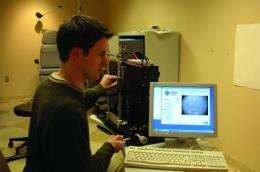Study offers hope for more effective treatment of nearsightedness

Research by an optometrist at the University of Houston (UH) supports the continued investigation of optical treatments that attempt to slow the progression of nearsightedness in children.
Conducted by UH College of Optometry assistant professor David Berntsen and his colleagues from The Ohio State University, the study compared the effects of wearing and then not wearing progressive addition lenses, better known as no-line bifocals, in children who are nearsighted. With funding by a National Institutes of Health National Eye Institute training grant and support from Essilor of America Inc. and the American Optometric Foundation Ezell Fellowship program, the study examined 85 children from 6-11 years old over the course of two years. The results were published in Investigative Ophthalmology and Visual Science, one of the most widely read journals in the field.
Selected according to their eye alignment and accuracy of focusing on near objects, the myopic children were fitted with either normal single-vision lenses or no-line bifocals to correct their nearsightedness. In addition to observing and testing the children, the doctors obtained feedback from parents and guardians of both the children's outdoor activities and near-work tasks, such as reading and computer use.
Previous research suggested that nearsighted children who do not focus accurately when reading books or doing other near work may benefit more from wearing no-line bifocal glasses than nearsighted children who focus more accurately. Berntsen's study found a small, yet statistically significant, slowing of myopia progression in children wearing the bifocals compared to those who simply wore single-vision lenses. Berntsen asserts, however, that the results do not suggest that children be fitted with no-line bifocal lenses solely for the purpose of slowing the progression of myopia.
"While the small effect found in the group of children wearing bifocal spectacles does not warrant a change in clinical practice, we found the beneficial effect was still present for at least one year after children stopped wearing no-line bifocal lenses," Berntsen said. "This is promising if other optical lens designs can be developed that do an even better job of slowing how fast myopia increases in children."
By understanding why different types of lenses result in the slowing of myopia progression, Berntsen says researchers will be better able to design lenses that may be more effective in slowing the increase of nearsightedness in children.
"Single-vision lenses are normally prescribed when a child gets a pair of glasses, but glasses with progressive addition lenses were shown to slightly reduce myopic progression in our study," Berntsen said. "For any treatment that reduces myopia progression in children to be useful, the effect of the spectacles or contact lenses must persist after children stop wearing them. The fact that the small treatment effect from our study was still present one year after discontinuing the treatment is promising. The results suggest that if newer optical designs currently being investigated do a better job of slowing myopia progression, the effects may be expected to persist and decrease how nearsighted the child ultimately becomes."
An important goal of this study, in particular, was to help them improve their understanding of the mechanism behind myopia progression in children and why no-line bifocals cause this small reduction in its progression. Berntsen says the study results and evidence from other studies suggest that lenses specifically designed to change blur in the eye's peripheral vision may be able to slow the increase of nearsightedness.
"There is support for continuing to investigate new lenses specially designed to change the blur profile on the back of the eye in order to reduce the increase of myopia in children," Berntsen said. "There is still further research to be done, but our work is an important step in discovering the methods needed to slow the progression of nearsightedness."
More information: The study, titled "A randomized trial using progressive addition lenses to evaluate theories of myopia progression in children with a high lag of accommodation," is available at www.iovs.org/content/53/2/640














